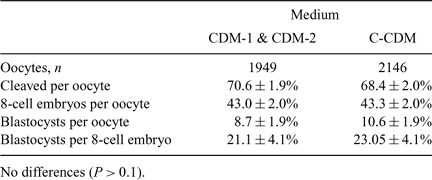121 DEVELOPMENT OF IN VITRO-PRODUCED BOVINE EMBRYOS CULTURED IN SEQUENTIAL OR CONTINUOUS MEDIA
L. S. Amorim A , D. J. Walker A and G. E. Seidel Jr AARBL, Colorado State University, Fort Collins, Colorado, USA
Reproduction, Fertility and Development 20(1) 141-141 https://doi.org/10.1071/RDv20n1Ab121
Published: 12 December 2007
Abstract
Slaughtered bovine females have different characteristics including age, nutritional status, breed, and management system, all of which may affect the results obtained in in vitro embryo production. Another key consideration is that early embryos move from the oviduct to a slightly different environment in the uterus, which has led to development of sequential embryo culture media (e.g. Lane M et al. 2003 Theriogenology 60, 407–419). However, the benefits and importance of using sequential media are not fully known. Therefore, the aim of the present study was to compare developmental rates of oocytes obtained from slaughterhouse-derived ovaries from cows or heifers after culture in sequential media (CDM-1, CDM-2) or in a continuous medium (C-CDM). The experiment was a 3 × 2 × 2 factorial design [bulls (A, B, or C), source (cows or heifers), and medium (sequential or continuous)]. Cumulus–oocyte complexes were aspirated, within 5 h of slaughter, from 3- to 8-mm ovarian follicles of cows (1482 oocytes) and fattened heifers usually fed melengesterol acetate (2818 oocytes). Embryos were produced in vitro as described by De La Torre-Sanchez et al. 2006 Reprod. Fertil. Devel. 18, 585–596, with slight modifications. Presumptive zygotes were vortexed to remove cumulus cells and cultured for 2.5 d in C-CDM (CDM supplemented with 5.0 mm L-lactate, essential and nonessential amino acids, and 0.5% FAF-BSA, or in CDM-1 (De La Torre-Sanchez et al. 2006 Reprod. Fertil. Devel. 18, 585–596) at 39°C in a humidified incubator under 5% CO2, 5% O2, and 90% N2. Cleavage was assessed after 2.5 d; 2- to 6-cell embryos were considered as cleaved, but were not cultured further. Embryos at the 7- to 8-cell stage were cultured for an additional 4.5 d in fresh C-CDM or CDM-2. The percentage blastocysts per oocyte was assessed after 7 and 8 days of culture. Data were arcsin-transformed and evaluated by ANOVA. There was a significant interaction between bull and ovary source for both 8-cell embryos and cleavage rate (P < 0.05); however, this interaction was no longer significant for blastocysts. No other interactions were significant nor a source of ovaries. Culturing embryos in CDM-C refreshed after cleavage evaluation (continuous) or culturing embryos in CDM-1 early and CDM-2 after cleavage evaluation (sequential) resulted in similar cleavage and blastocyst rates (Table 1). We conclude that bovine embryos can be produced using a single chemically defined medium (+BSA) with similar efficacy as a system using 2 sequential media.

|


